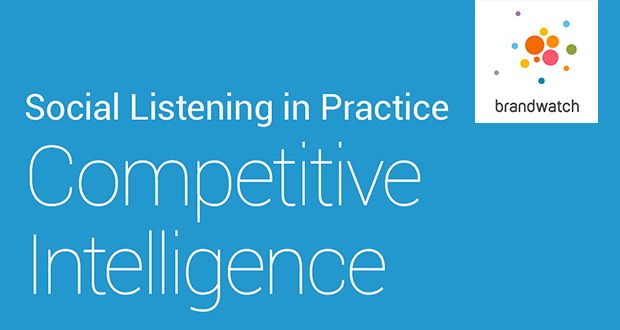The popularity and massive use of social media can be extremely beneficial for your business if used effectively. Being able to gather and analyze the hundreds of thousands of opinions spewed online every day about both your and your competitor’s products can single-handedly turn your brand around. Brandwatch’s services allow for you to take advantage of posts about your brand released to social media and use the information to benefit your business. Their new guide on competitive intelligence lays out what they offer and why it’s important.
What is Competitive Intelligence?
Competitive intelligence is defined by Brandwatch as what “allows businesses to make strategic decisions based on a stronger understanding of their position or reputation within a given market.” With competitive intelligence a brand can effectively evaluate what they are doing right and what might need to change. Found in their new guide on competitive intelligence are 5 overarching categories of analysis that I will go more in depth about below.
Foundational Analysis
Share of voice is the first big tool that Brandwatch goes over in their guide on competitive intelligence. Share of voice allows for brands to see just how much online presence they have when compared with other competitors. While this sounds like a very basic and introductory metric, it’s power should not be over looked. Knowing where your business stands in relation to your competitors online is a necessary starting point for improving your marketing. As new products are released and your brand evolves, this tool will also allow for you to see how you continue to compare to, and hopefully progress against, your competition.
Audience Analysis
Regional share of voice is very similar to the basic share of voice in foundational analysis, but this analysis goes more in depth. With regional share of voice, you are able to see which part of the country, state, or region is specifically talking about your product. Information like this can be extremely beneficial when it comes to deciding on expanding your business to a new region or even specific marketing tactics and techniques used in each area.
Product Positioning & Associations
When it comes to the product positioning and associations section of the guide on competitive intelligence we get information more regarding each individual brand. Here we can see how each product is performing compared with other products within the same brand. This is important information to know because this lets your business understand which line is being talked about the most. Information here might provide date on what you already know based off of current sales, or it might bring in a new light regarding a product that you had previously overlooked. Knowing which specific product is performing well and getting a buzz in the market place is sure to give you an edge on your competitors. Also using social intelligence, it is now possible to view the language that is being associated with your brands online. How you word and phrase your brand is important, but what others are wording your brand as is even more important.
Sales Projections
Understanding the intent of your customers to purchase your product can be a difficult thing. Many different influences go into whether or not a customer makes a purchase these days, but using social intelligence can allow us to get a good grasp on some possible reasoning. By measuring the online mentions of customer’s intent on purchasing a product, a business can try to evaluate if an ad campaign was successful, or what other tactics are currently being performed right or wrong. While intent to purchase is definitely not the same as an actual purchase, the knowledge that your brand is being discussed and remains relevant in the market place is extremely beneficial, especially when it comes to evaluating the effectiveness of a campaign.
Brand Perception
Brand perception is the last of the big metrics talked about in the new guide on competition intelligence, but is still 100% crucial for businesses to take advantage of. Having a good understanding of how your brand is perceived is necessary to make any beneficial and long lasting changes. Understanding your weaknesses can lead to the development of a strong competitive strategy in your field. This new understanding of what problems are being discussed about your brand can allow for your business to pinpoint and fix these specific issues, ultimately appealing to your customers and eventually others.
 Social Media Data Insights & Resources for Social Media
Social Media Data Insights & Resources for Social Media




Pingback: Brandwatch’s New Guide on Competitive Int...